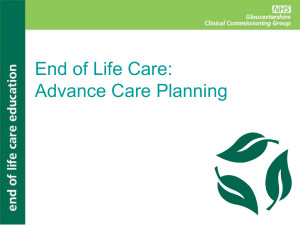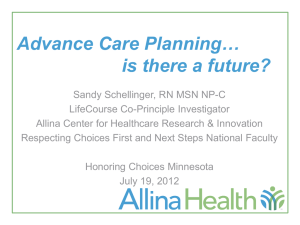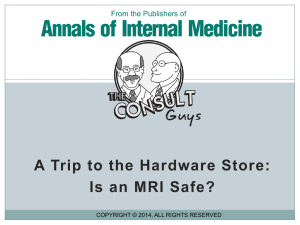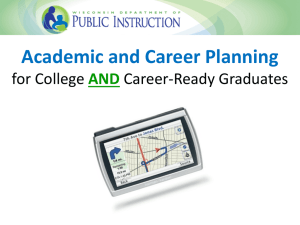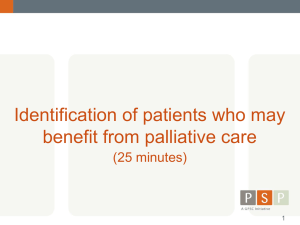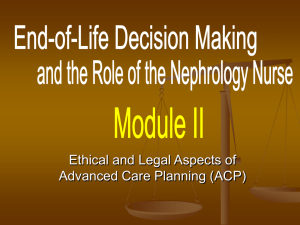A Late Life Supportive Care Research Project Sandy Schellinger
advertisement
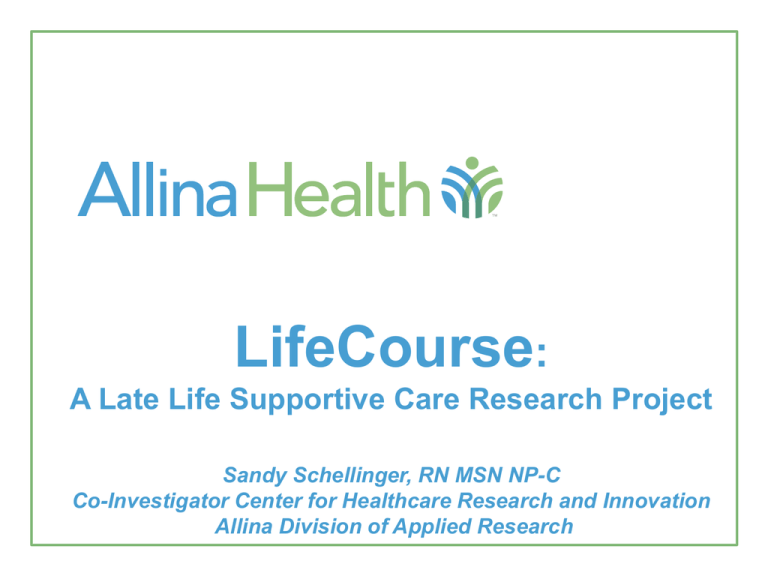
LifeCourse: A Late Life Supportive Care Research Project Sandy Schellinger, RN MSN NP-C Co-Investigator Center for Healthcare Research and Innovation Allina Division of Applied Research Objectives Participants will be able to: Describe the LifeCourse Late Life Supportive Care Model Understand and describe how advance care planning should be integrated into the late life experience. 2 A Robina Foundation grant in partnership with Abbott Northwestern Hospital, Allina Clinic and Community Division, independent physicians, Walker Methodist, and Augustana Care to develop a new supportive care model for individuals late in life. 6-Year Study Timeline Phase I: Design/build care model 2012 2013 - 2014 Phase II: Validation 2015 - 2017 Model Foundation: The Felt Experiences of Care • Wife of a chronically ill husband: “We’ve been in the hospital and five different care centers. It’s like starting over every time.” • A family caregiver: “Hospice was great. We couldn’t have done it without them. But all of a sudden they took over and said, ‘You can be the family now.’ I felt like our years of caregiving were invisible.” • A son caring for his father at home: “The only time I felt out of control of my dad’s care was when we went into the hospital.” • A surgeon at Abbott Northwestern: “How can we reclaim the heart of medicine?” AIM As I live well with serious illness, I am in charge. You listen to me, help me, guide me, honor me, and support me as a person. Relationship based patient centered support across care settings in the last years of life will prove to reliably honor and respect patient goals and wishes, improve quality of life, enhance the care experience and reduce unwanted or unnecessary care. relationship + story Relationship as how to do work STORY Relationship as result of work THE WORK_domains Culture THE WORK_Guiding Principles THE MODEL_Active Ingredients Patient & Caregiver Outcomes Patient Outcomes Patient Goals & Wishes Honored Patient Quality of Life Patient Experience Patient Experience Caregiver Outcomes Primary Caregiver Quality of Life Primary Caregiver Experience Secondary Caregiver Quality of Life Care Team Outcomes & Process Evaluation Care Team Wellbeing Care Team Activity 14 System Outcomes Hospice Enrollment Hospice Days Inpatient Days Total Cost of Care How Will We Do This? The LifeCourse non-clinical care guide establishes an ongoing, personal relationship to hear the life story and understand goals of living. The team supporting the care guide helps to maintain focus on the whole person, so that non-medical as well as medical goals are established and supported. The care guide partners with patients and caregivers to get the right support from within Allina, from their community, and from the family’s own strengths and assets. 16 Care guide vs Team Shared relationship • The team shares a connection with the patient. • The care guide provides continuity over time; the clinicians provide focused expertise. • Therapeutic relationship (care guide) is not the same as Therapy (clinician). PCP RN Chaplain SW Care guide M&FT Pharmacy Participant and Caregivers 17 The LifeCourse Model • The team for 300-500 patients: – – – – – – 9 care guides An RN A Social Worker A Marriage and Family Therapist A Chaplain A Pharmacist • Care Guides – Two years of post-secondary education – Experience in loss or caregiving – Good communication skills 18 Team: Skills and Licenses— Weighted in favor of a common set of interpersonal skills • • – – • • • • • • • • • Assessment Advance Planning Shared decision making Advance Care Planning Communication Coordination Team Dynamics Cultural understanding Critical thinking and clinical judgment Facilitator of learning Process Improvement Systems thinking Common Knowledge Base 19 Discipline-specific competencies DisciplineSpecific skills What are the training concepts and foundations? Training Patient Care Tending to suffering, soul & resilience Advance Planning (ACP/SDM) Domains of Personhood Story review Adaptive Practices Coordination / follow up enhance & support Relationship Story Validation and planning Understand strengths & resources Communication/ Narrative Interviewing Late Life Adaptive Practice Based on Heifeitz, R. and Limky, M. Leadership on the line. Harvard Business School Press. Boston, MA, 2002, page 108. DISTRESS! Tension of Change Limit of tolerance Patient and families productive range of adaptation, engagement and coping. Threshold of learning DISTRESS! 21 Time A Life’s Journey • Chuck was 81 years old: a father, a veteran, a man of strong faith. • He was an engineer who loved to golf, fish, and work in his woodshop. • He died at home of heart failure 12 years after a kidney transplant. • In his last year of life, Chuck and his wife faced many challenges. Aortic Stenosis Pulmonary Hypertension Renal Failure Recurrent Pneumonia • Weight loss, weakness, fatigue, fluid retention, shortness of breath, anxiety, depression, insomnia, anticoagulation, general malaise, osteoarthritic pain. • Hospitalization Comfort care vs limited intervention vs full treatment • Shortness of breath Oxygen & morphine versus Diuresis renal failure vs heart failure. • Fluid retentions Peritoneal versus hemo dialysis • Anemia Procrit; Iron infusions • Malnutrition upper GI Low adaptation Burden of illness High ACP OR SDM? Illness TIME Death Advance Planning Shared Decision Making(SDM) Advance Care Planning(ACP) • • • • • Patient Centered Individualized Whole person Decision Making Goals, values and preference dependent Shared Decision Making Advance Planning Advance Care Planning Advance Planning • • • • Shared Decision Making Present Specific Decision Multiple Choices Life or treatment options • Change in goals, prognosis, health status, support, medical plan • Collaborative Conversation Advance Care Planning Advance Planning • Future • Surrogate decision making • Unplanned Complications • Planning for bad Shared outcomes Decision • Change in goals, prognosis, health making status, support, medical plan Advance Care Planning Advance Care Planning is … • Discussion to understand and • Document Goals, values and treatment wishes into an advance directive document. • Communicate to others verbally and in medical record the most recent documentation and discussion. Hospital Admission Change in Condition Care Transition clarify goals, values and wishes and decide on treatment options. Function Life Course of Advance Care Planning Prevention-Wellness-Illness Management-Acute Care-End of Life 30 Function Basic Planning all adults Basic HCD completion ID Health care agent Clarify goals values Treatment wishes Neurological injury Prevention-Wellness-Illness Management-Acute Care-End of Life Life Course of Advance Care Planning 31 Life Course of Advance Care Planning Basic Planning all adults Function Disease Specific Planning Any Age-progressive illness Facilitator, Patient, Proxy 90 minutes Individualized Goals of care Unplanned complications, “bad” outcomes Prevention-Wellness-Illness Management-Acute Care-End of Life 32 Life Course of Advance Care Planning Function Basic Advance Care Planning Disease Specific End of Life – 6-12 mos to live POLST Hospice Medical /LTC Order Set Specific Treatments Prevention-Wellness-Illness Management-Acute Care-End of Life 33 adaptation Burden of illness Disease Specific ACP Low High POLST Basic ACP Patient’s Journey ACP vs. SDM Illness TIME Death Advance Planning • • • • Shared Decision Making Present Specific Decision Multiple Choices Life or treatment options • Change in goals, prognosis, health status, support, medical plan • Collaborative Conversation Advance Care Planning Decisional Conflict Signs & Symptoms Concerned about “bad results” Wavering between choices Delaying decision Questioning what is important Distressed/tense Preoccupied with decision “A state of uncertainty about the course of action to be taken when choice among competing actions involves risk, loss, or challenge to personal values.” Common goals at the end of life • • • • • • Be cured Live longer Maintain function/quality of life/independence Be comfortable Achieve life goals Provide support for family and caregiver Goals toward the end of life: A structured review. Kaljian et al., 2009 37 Medication High Hospital Hospital Clinic visits Clinic visits Dialysis, Tests & Procedures Comfort Care vs. Hospital Dialysis, Tests & Procedures Disease Specific ACP adaptation Hospital Low Burden of illness POLST Basic ACP ACP AND SDM Illness TIME Death Clinic visits Hospital Low Disease Specific ACP Depression Illness TIME Shortness of Breath Dialysis, Tests & Procedures Hospital Fluid retention adaptation Clinic visits Insomnia Dependence Burden of illness High Hospital Anorexia Nausea POLST Basic ACP ACP AND SDM Comfort Care vs. Hospital Dialysis, Tests & Procedures Death Dialysis, Tests & Procedures Hospital Depression Move to Asst. living No longer driving Illness TIME Shortness of Breath Adaptation Clinic visits Disease Specific ACP High Hospital Anorexia Nausea Medication Insomnia Hospital Clinic visits Fluid retention Burden of illness Caregiving help Sell House Dependence Low help POLST Basic ACP ACP AND SDM Caregiving Comfort Care vs. Hospital Dialysis, Tests & Procedures Death LifeCourse Collaborative Conversations (communication and relationship) Paternalistic Conversations Shared Decision Making Autonomous Conversations (Clinician) Conversations (Person) (dyad activity) Shifting 41 from Shared to Collaborative Decision Making: A Change in Thinking and Doing (O’Grady & Jadad, 2010) LifeCourse Team ACP/SDM Cues Assessment and Plan Team Roles and Responsibilities 42 • SDM Cues – intensity and urgency • New or changed diagnosis • Change in roles or responsibilities • Change in care setting or living situation • Change in functional and cognitive status • Change in treatment plan • Chang in support system • Facilitator/Guide • Communicator • Navigator/Coordinator • Coach • Informer/Educator • Advocate/Advisor Decision 43 Goal Summary Best Practice Late Life Care • Relationship continuum based care - Patient Driven • Honoring patient goals, values and wishes - ACP • Empower, Engage & Activate - SDM • Proactive Support - Strength, Assets and Gaps • Best Practice Standards Education and Training Improve Care experience and Quality of life 44 Thank you Sandy Schellinger 612-262-1444 sandra.schellinger@allina.com 45


